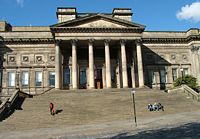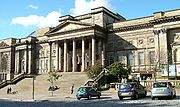
William Brown Library and Museum
Encyclopedia


William Brown Street
William Brown Street in Liverpool, England is a road that is remarkable for its concentration of public buildings. It is sometimes referred to as the "Cultural Quarter"...
in Liverpool
Liverpool
Liverpool is a city and metropolitan borough of Merseyside, England, along the eastern side of the Mersey Estuary. It was founded as a borough in 1207 and was granted city status in 1880...
, England
England
England is a country that is part of the United Kingdom. It shares land borders with Scotland to the north and Wales to the west; the Irish Sea is to the north west, the Celtic Sea to the south west, with the North Sea to the east and the English Channel to the south separating it from continental...
. The building currently houses part of the World Museum Liverpool
World Museum Liverpool
World Museum is a large museum in Liverpool, England which has extensive collections covering archaeology, ethnology and the natural and physical sciences. Special attractions include the Natural History Centre and a free Planetarium. Entry to the museum itself is also free...
and Liverpool Central Library
Liverpool Central Library
Liverpool Central Library is the largest of the 22 libraries in Liverpool, England, situated in the centre of the city.-Buildings:The library is located in several adjoining historic buildings on the city's historic William Brown Street...
.
The William Brown Library and Museum building was conceived as a replacement for the Derby Museum (containing the Earl of Derby
Earl of Derby
Earl of Derby is a title in the Peerage of England. The title was first adopted by Robert de Ferrers, 1st Earl of Derby under a creation of 1139. It continued with the Ferrers family until the 6th Earl forfeited his property toward the end of the reign of Henry III and died in 1279...
's natural history
Natural history
Natural history is the scientific research of plants or animals, leaning more towards observational rather than experimental methods of study, and encompasses more research published in magazines than in academic journals. Grouped among the natural sciences, natural history is the systematic study...
collection) which then shared two rooms on the city's Duke Street with a library. The land for the building on what was then called Shaw's Brow as well as much of the funding was provided by local MP
Member of Parliament
A Member of Parliament is a representative of the voters to a :parliament. In many countries with bicameral parliaments, the term applies specifically to members of the lower house, as upper houses often have a different title, such as senate, and thus also have different titles for its members,...
and merchant Sir William Brown, 1st Baronet of Astrop, in whose honour the street was renamed.
Following on from the then-recently completed St. George's Hall
St. George's Hall, Liverpool
St George's Hall is on Lime Street in the centre of the English city of Liverpool, opposite Lime Street railway station. It is a building in Neoclassical style which contains concert halls and law courts, and has been designated by English Heritage as a Grade I listed building...
across the street, the new building was designed by Thomas Allom
Thomas Allom
Thomas Allom was an English architect, artist, and topographical illustrator. He was a founding member of what became the Royal Institute of British Architects . He designed many buildings in London, including the Church of St Peter's and parts of the elegant Ladbroke Estate in Notting Hill...
in a classical style including Corinthian columns
Corinthian order
The Corinthian order is one of the three principal classical orders of ancient Greek and Roman architecture. The other two are the Doric and Ionic. When classical architecture was revived during the Renaissance, two more orders were added to the canon, the Tuscan order and the Composite order...
and was modified by the Liverpool Corporation architect John Weightman. The new building opened its doors in 1860 with 400,000 people attending the opening ceremony.
With Liverpool being one of the country's key ports, much of the city was badly damaged by German bombing during the Second World War and William Brown Library and Museum were no exception. Hit by firebombs during the blitz
Liverpool Blitz
The Liverpool Blitz was the heavy and sustained bombing of the British city of Liverpool and its surrounding area, at the time mostly within the counties of Lancashire and Cheshire but commonly known as Merseyside, during the Second World War by the German Luftwaffe.Liverpool, Bootle, and the...
in 1941, the building was ravaged by fire and much of the building had to be rebuilt. Fortunately, key parts of the museum's collection had been previously moved to less vulnerable locations.
Plans have now been brought forward to redevelop the library, replacing the post world war II additions with state-of-the-art facilities.

